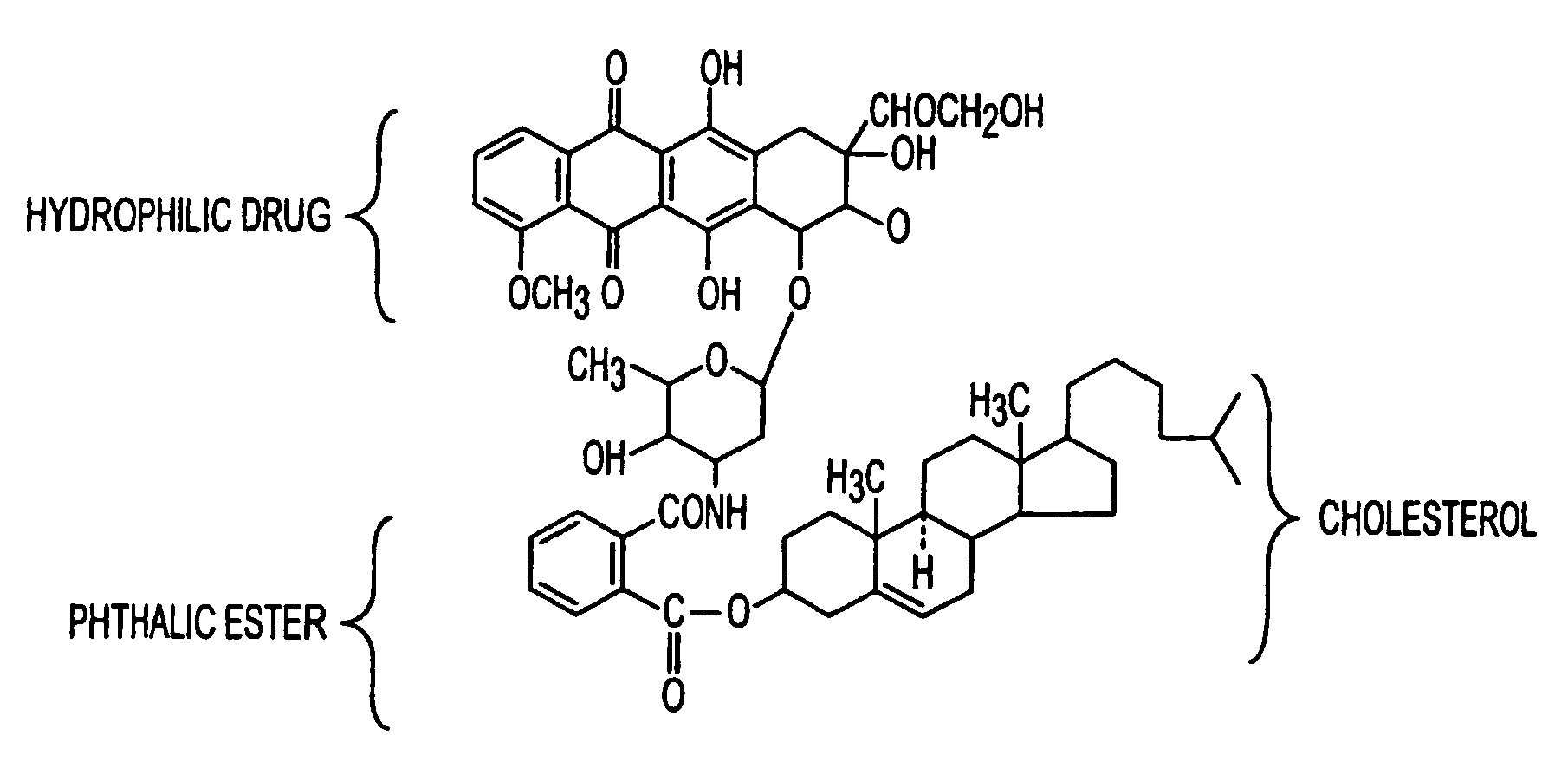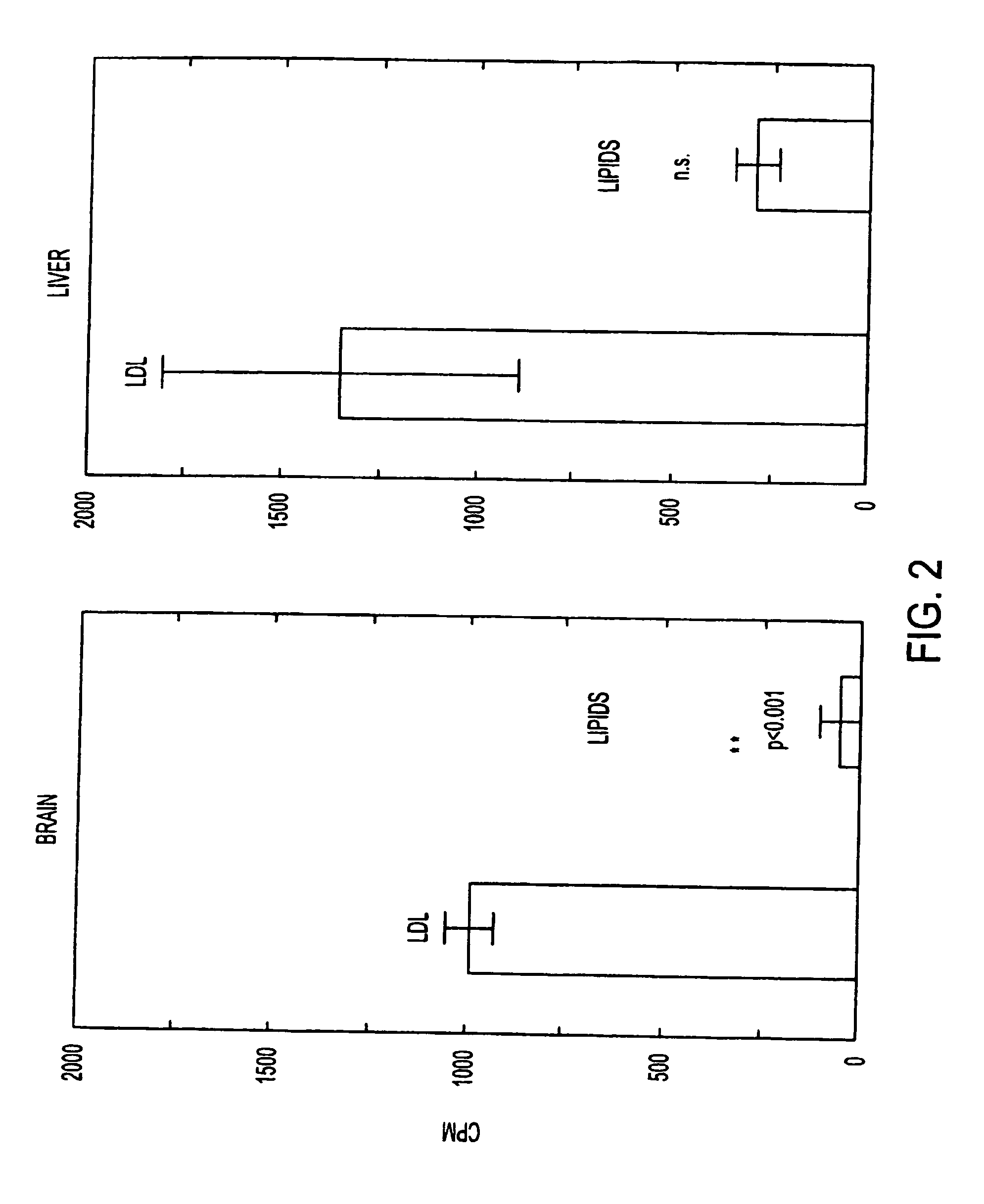Artificial low-density lipoprotein carriers for transport of substances across the blood-brain barrier
a technology of low-density lipoproteins and carriers, applied in the direction of drug compositions, peptides, metabolism disorders, etc., can solve the problems of alzheimer's disease, major difficulties in the pharmacological treatment of brain diseases and central nervous systems, etc., to facilitate and improve treatment, facilitate incorporation of conjugated therapeutic agents
- Summary
- Abstract
- Description
- Claims
- Application Information
AI Technical Summary
Benefits of technology
Problems solved by technology
Method used
Image
Examples
example 1
Purification of Full-Length Apoprotein E (ApoE)
[0120]DMPC (1,2-dimyristoyl-sn-glycero-3-phosphocholine) from Avanti Polar Lipids, Inc. is suspended in benzene at a concentration of 100 mg / ml in a glass tube and sonicated using bench top sonicator. The DMPC suspension is shell-frozen and lyophilized overnight, then resuspended in 30 ml standard buffer (10 mM Tris-HCl. pH 7.6. 0.15M NaCl, 1 mM EDTA. 0.0005% NaN3) to make 10-20 mg / ml DMPC and transferred to a plastic 50 ml conical tube. The tube is placed in a water bath and sonicated using a sonicator with a microtip for four 10 min intervals, interspersed with 2-3 min cooling. Sonication is repeated until the solution becomes nearly transparent. The sonicated DMPC is then centrifuged at 2000 rpm for 20 minutes to remove any titanium that may have sloughed off during sonification.
[0121]Bacterial cells expressing cloned ApoE are collected by centrifugation and sonicated on ice in a Branson Sonifier with a large tip, using four periods ...
example 2
ApoE Enrichment of LDL-Liposomes
[0125]1. Preparation of lipid cake: Egg yolk phosphatidylcholine (25 mg) and cholesteryl oleate (2 mg) are dissolved (ratio 25:1) in methanol / chloroform (2:3). The solvent is evaporated under nitrogen at 4° C.
[0126]2. Preparation of liposomes: The lipid cake is hydrated in 12 ml of 10 mM Tris-HCl buffer, p H 8.0, containing 0.1M potassium chloride previously bubbled under nitrogen gas. The mixture is sonicated for 1 h at 18-um output under nitrogen stream at 54° C. and centrifuge to remove any titanium particles produced during sonication.
[0127]3. Preparation of artificial LDL: The liposomes prepared in step 2 are incubated with ApoE protein in a ratio of 1 / 10 (w / w) protein / lipid for 30 min at 37° C. The liposomes are then purified and concentrated by density gradient ultracentrifugation at 285,000×g for 18 h at 4° C. using a three-layer KCl step gradient with densities of 1.064, 1.019, and 1.006 g / cm3. KBr is added to the liposome solution to raise i...
example 3
Uptake of Artificial LDL Particles in Brain
[0128]The 14C-LDL suspension in PBS, containing approx. 1 mg lipid, was injected into the tail vein of a Sprague-Dawley rat (150g). At various intervals, blood samples were obtained by cardiac puncture using syringes containing EGTA. Blood plasma, RBCs, and tissues were homogenized in water and the 14C was measured in a scintillation counter.
[0129]FIG. 2 shows the results of uptake of LDL and lipids in brain (left) and liver (right). Male Sprague-Dawley rats were injected intravenously with LDL or lipid particles containing 14C-cholesterol and radioactivity in brain and liver was measured two hours later. Brain and liver took up 19.8 and 4.7 times more label, respectively, from LDL compared to lipid particles of identical composition except for the presence of ApoE. This indicates that the uptake was caused by transcytosis mediated by the LDL receptor (p(>T)=0.00055).
[0130]FIG. 3 (left) shows the ratio of LDL uptake to lipid particle uptake...
PUM
| Property | Measurement | Unit |
|---|---|---|
| Time | aaaaa | aaaaa |
| Diameter | aaaaa | aaaaa |
| Diameter | aaaaa | aaaaa |
Abstract
Description
Claims
Application Information
 Login to View More
Login to View More - R&D
- Intellectual Property
- Life Sciences
- Materials
- Tech Scout
- Unparalleled Data Quality
- Higher Quality Content
- 60% Fewer Hallucinations
Browse by: Latest US Patents, China's latest patents, Technical Efficacy Thesaurus, Application Domain, Technology Topic, Popular Technical Reports.
© 2025 PatSnap. All rights reserved.Legal|Privacy policy|Modern Slavery Act Transparency Statement|Sitemap|About US| Contact US: help@patsnap.com



